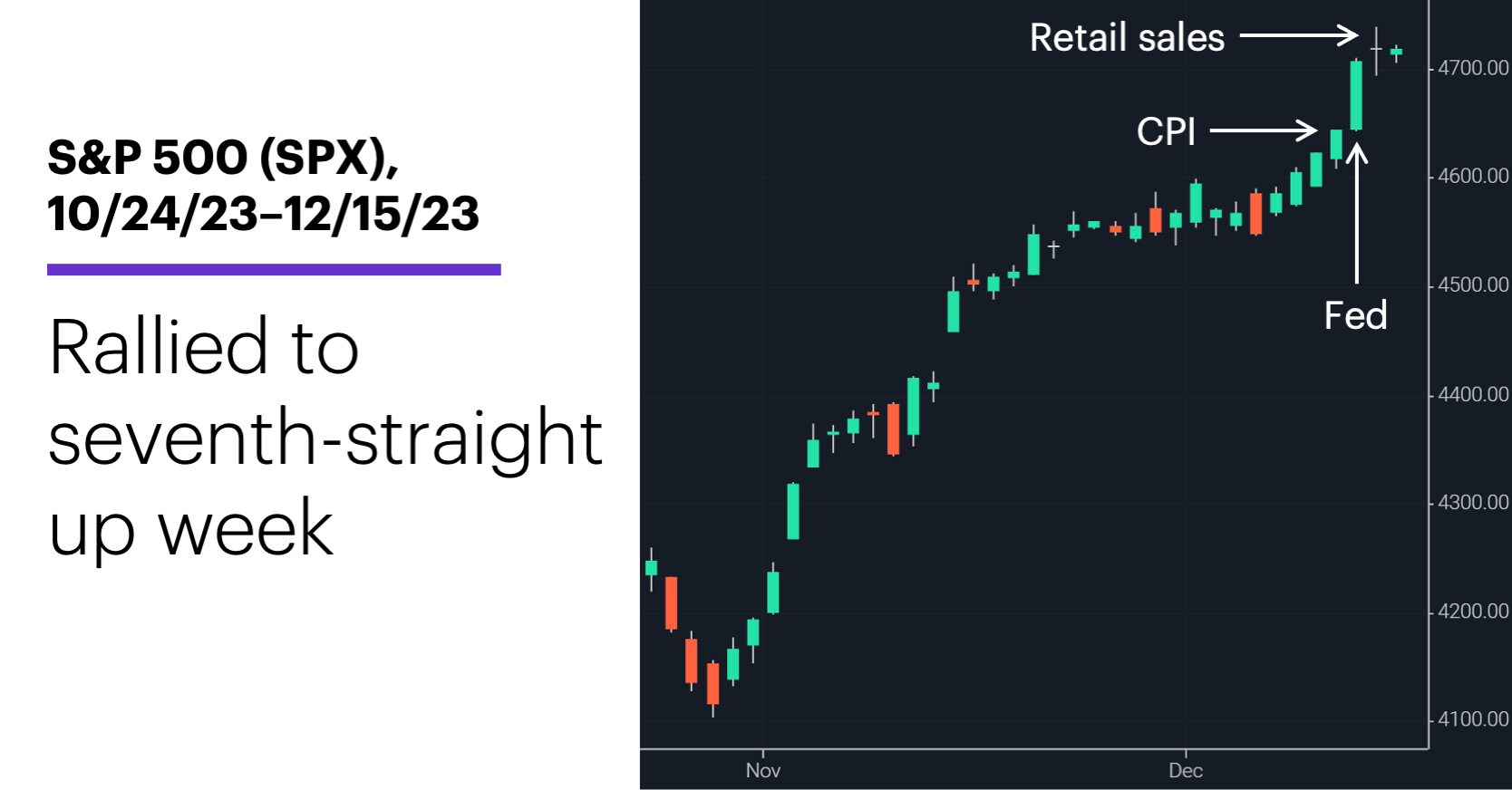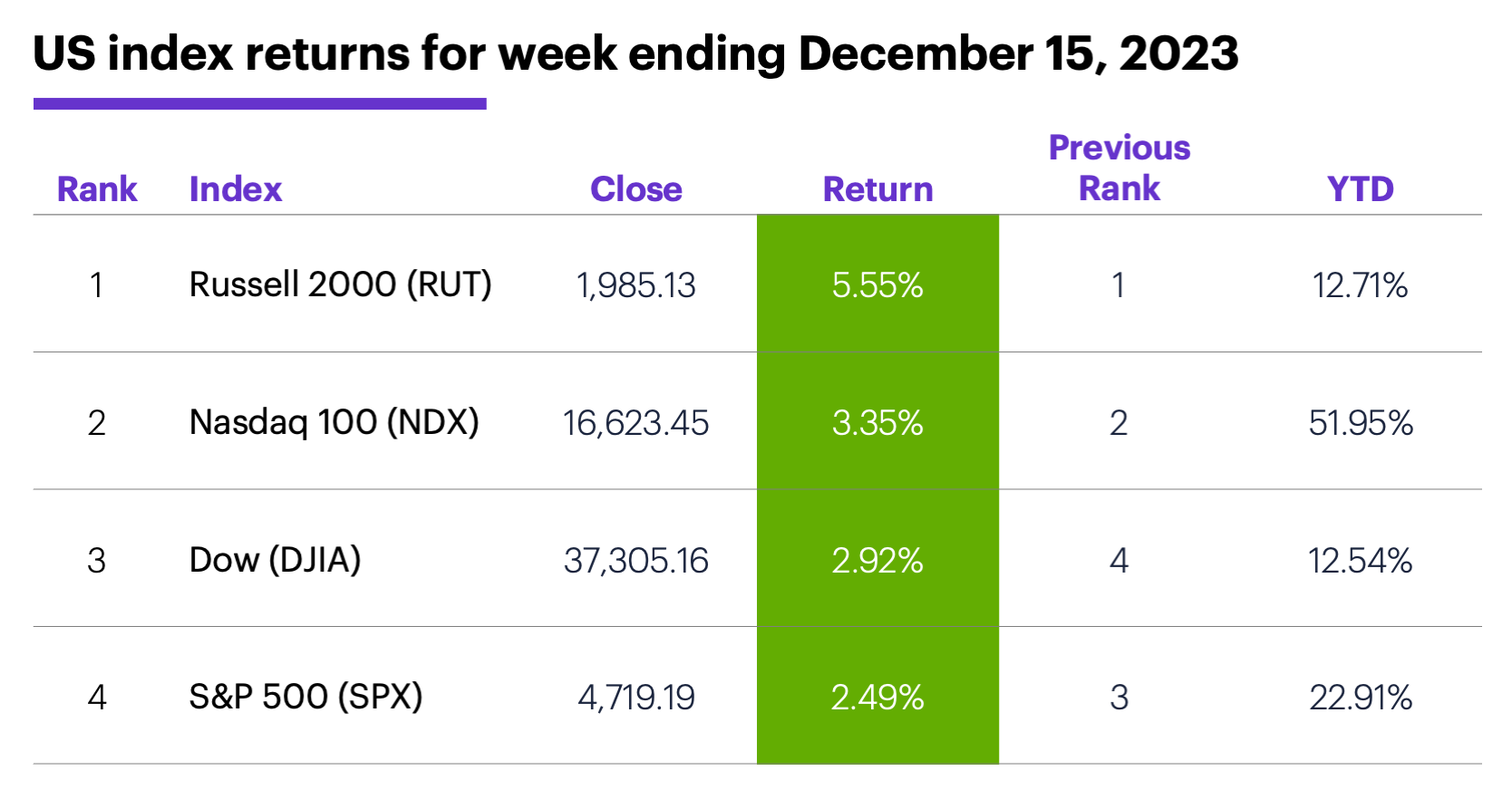Market keeps on giving
- Market embraces Fed outlook, notches 7th up week
- Dow and NDX set records, bond yields tumble
- This week: Durable goods, Fed inflation, housing
Entering the home stretch of an always-surprising 2023, US stocks are in a place few people probably thought they would be several weeks ago, let alone several months ago.
The market extended its fall surge last week as the Federal Reserve signaled it was prepared to cut interest rates next year, with the Dow Jones Industrial Average (DJIA) and Nasdaq 100 (NDX) both setting new all-time highs. The S&P 500 (SPX) narrowly missed a seventh-straight up day on Friday, but it still posted its seventh-consecutive positive week—its longest such run since 2017:

Source: Power E*TRADE. (For illustrative purposes. Not a recommendation. Note: It is not possible to invest in an index.)
The headline: Fed gives gift to bulls.
The fine print: The Fed held interest rates steady last Wednesday and pivoted to a more-dovish outlook for next year. Interestingly, though, Tuesday’s Consumer Price Index (CPI) inflation report was a little warmer than anticipated, and some of the week’s other major economic numbers, including retail sales, were stronger than expected.
The number: 3, the number of rate cuts the Fed projects for next year—less than the four the market has been pricing in for a while, but more than the Fed had previously indicated it would issue.
The move: The DJIA rallied to consecutive all-time highs last Wednesday-Friday (topping 37,000 for the first time), while the NDX closed at a record high on Friday.
The scorecard: The small-cap Russell 2000 (RUT) didn’t set any new records, but it led the market for a third week:

Source (data): Power E*TRADE. (For illustrative purposes. Not a recommendation.)
Sector returns: The strongest S&P 500 sectors last week were real estate (+5.3%), materials (+4%), and industrials (+3.6%). The weakest sectors were communication services (-0.1%), utilities (+0.9%), and health care (+1.6%).
Stock movers: Icosavax (ICVX) +49% to $15.68 on Tuesday, Acadia Pharmaceuticals (ACAD) +34.48% to $28.47 on Wednesday. On the downside, Biomea Fusion (BMEA) -30% to $11.77 on Monday, Keros Therapeutics (KROS) -21% to $28.33 on Monday.
Futures: Last Wednesday, January WTI crude oil (CLF4) fell to its lowest low since late June ($67.71), but rebounded to end the week slightly higher at $71.43. February gold (GCG4) followed a similar script, reversing off a three-week intraday low of $1,987.90 on Wednesday to end the week higher at $2,035.70. Week’s biggest gains: March palladium (PAH4) +26.4%, March coffee (KCH4) +6.9%. Week’s biggest losses: March sugar (SBH4) -5.9%, December Micro bitcoin (MBTZ3) -5.5%.
Coming this week
Plenty of numbers are lined up for the week before Christmas, including Fed inflation (PCE Price Index), the final Q3 GDP estimate, and Durable Goods Orders:
●Monday: NAHB Housing Market Index
●Tuesday: Housing Starts and Building Permits
●Wednesday: Q3 Current Account , Consumer Confidence, Existing Home Sales
●Thursday: GDP (Q3 final), Leading Economic Indicators Index
●Friday: Durable Goods Orders, Personal Income and Spending, PCE Price Index, Consumer Sentiment, New Home Sales
Earnings this week include:
●Monday: Heico (HEI)
●Tuesday: Accenture (ACN), FedEx (FDX)
●Wednesday: General Mills (GIS), Winnebago (WGO), Micron (MU)
●Thursday: Cintas (CTAS), CarMax (KMX), Nike (NKE)
Check the Active Trader Commentary each morning for an updated list of earnings announcements, IPOs, economic reports, and other market events.
Overextended or on a roll?
As last week wound down, the stock rally lost a bit of momentum. On Thursday, the SPX and the Cboe Volatility Index (VIX) both closed higher, something that’s often preceded at least a day or two of sub-par market performance.1 Whether that will turn into something more significant remains to be seen. Even the strongest trends experience pauses and reversals and, among other factors, the SPX is facing potential resistance at its 2022 all-time highs.
Also, while some traders may view the SPX’s seventh-straight up week as a contrarian signal—a potentially overextended trend that is ripe for a pullback—the historical record doesn’t necessarily back up that perspective. The SPX has had 33 other seven-week streaks since 1940, and four weeks later the index was higher more often than lower, with a median return (1.5%) that was larger than its overall four-week median return (1%).2
Click here to log on to your account or learn more about E*TRADE's trading platforms, or follow the Company on Twitter, @ETRADE, for useful trading and investing insights.
1 Reflects Cboe Volatility Index (VIX) and S&P 500 (SPX) daily price data, 1/2/90–12/15/23. The specific pattern reflects a day on which the VIX closes at a two-day (or longer) high and the SPX also closes higher. Supporting document available upon request.
2 Reflects S&P 500 (SPX) weekly closing prices, 1/2/40–12/15/23. Supporting document available upon request.